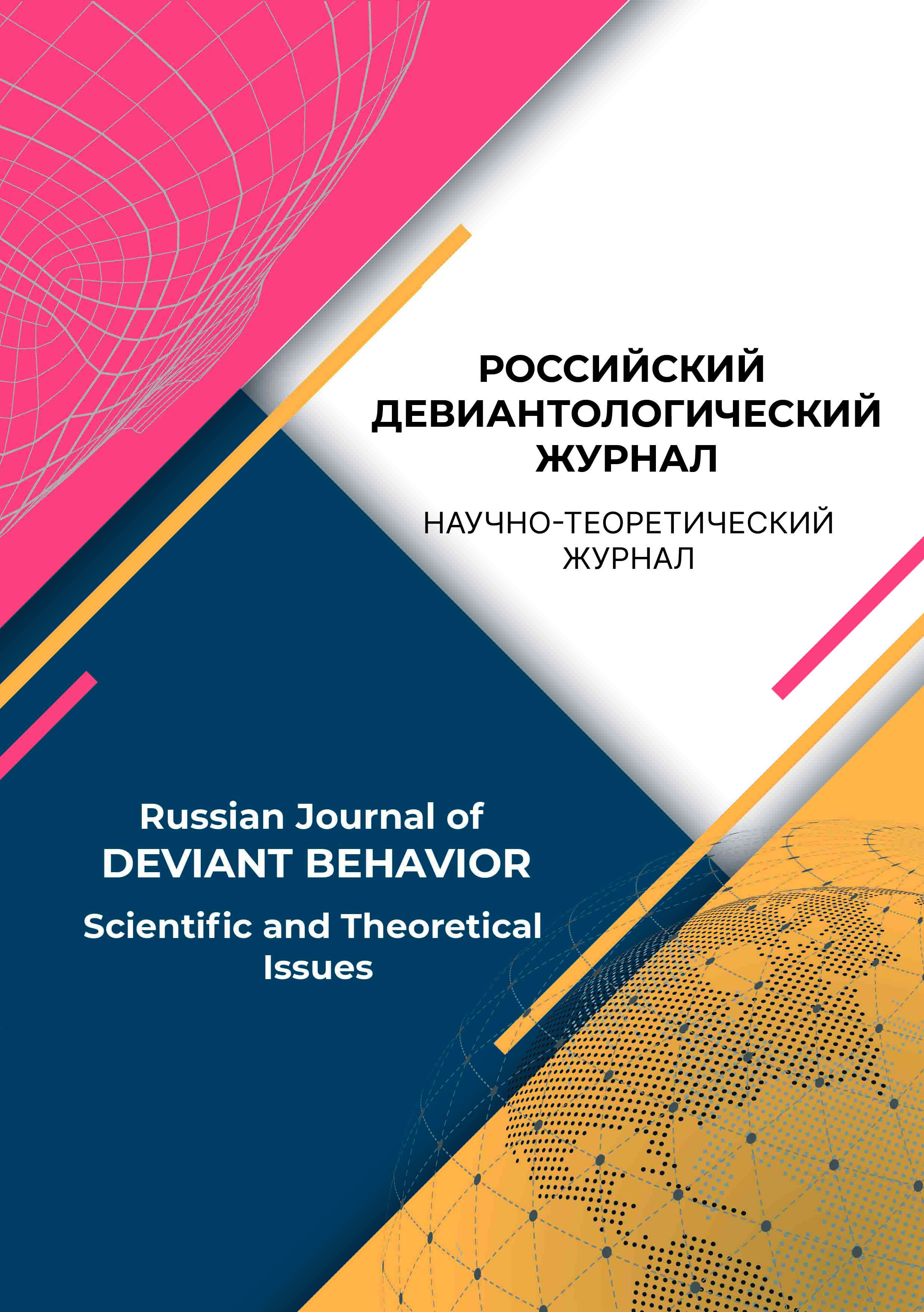St. Petersburg, St. Petersburg, Russian Federation
from 01.01.2018 to 01.01.2021
Trjavna, Bulgaria
Introduction. The significance of social connections is due to diverse and crucial impact of environment to human life. The study of social connections enables to identify a person’s living standard and wellbeing. Addressing homeless people means better awareness and the opportunity to organize psychological assistance to them as well as to clarify the issue of social ties formation. The study aims to review the theoretical concept of personal social connections and to analyze the homeless’ subjective views on their state. The research tasks are to review a social connections structure; to carry out research on the homeless’ social connections and to analyze the characteristics of these ties. Methodology. The social-subjective approach to social interaction is the key methodology of the study. It enables to form a concept of the homeless’ ties with other people and build the model of their social interaction. The advantage of the approach is the possibility to research the social ties of the homeless, to gather data about the parameters of these connections, to understand how the homeless perceive people around them, the society and themselves. The main method of the study was the self-report. The survey on quantitative and qualitative characteristics of social connections of the homeless as well as the questionnaire on the key parameters of the person’s interaction with society (getting support from the social environment, self – assessment of the interaction, the impact on social environment) were conducted. The data were processed by descriptive statistics and Kruskal–Wallis H test. The sample of the study consisted of 197 participants aged 45–50. The majority of the sample (80%) was male. The research procedure. We compared the subjective awareness of social interaction of the homeless and people who have accommodation. Our results show the decrease of social impact on the person among the homeless. It is determined by low rapport, poor interpersonal communication, low authority and low reference as well as little value of social environment. The research reveals that the homeless make an improper evaluation of their interaction with social environment. That results in low assessment of social support, underestimation of their own impact on the environment and overestimation of their ability to interact. Scientific novelty. The findings of the study expand the understanding of the state of homelessness. They reveal socialpsychological characteristics of the homeless interaction with the environment as well as specifies the concept of socialperceptive ideas formed during these interactions with the environment. Practical significance. This study emphasizes the necessity of forming the homeless social skills, indicates the issues of psychological prevention in counseling and providing social assistance to this category of citizens.
the homeless, social interaction, social work, difficult life situation
1. Barnett, I. (1968). American Hippies and Activists. International Journal of Offender Therapy, 12(2), 71-72. DOIhttps://doi.org/10.1177/0306624x6801200202
2. Baron, S. W. (2017). Street Youth, Social Schemas, and Crime. Criminal Justice and Behavior, 44(12), 1620-1638. DOI:https://doi.org/10.1177/0093854817726805.
3. Baumeister, R. F., & Leary, M. R. (1995). The need to belong: Desire for interpersonal attachments as a fundamental human motivation. Psychological Bulletin, 117(3), 497-529. DOI:https://doi.org/10.1037/0033-2909.117.3.497
4. Biswas-Diener, R., & Diener, E. (2006). The subjective well-being of the homeless, and lessons for happiness. Social Indicators Research, 76(2), 185-205. DOI:https://doi.org/10.1007/s11205-005-8671-9
5. Błoch, A., Vasques Filho, D., & Bojanowski, M. (2020). Networks from archives: Reconstructing networks of official correspondence in the early modern Portuguese empire. Social Networks. DOI:https://doi.org/10.1016/j.socnet.2020.08.008
6. Cobb-Clark, D., Herault, N., Scutella, R., & Tseng, Y. (2016). A journey home: What drives how long people are homeless? Journal of Urban Economics, 91, 57-72. DOI:https://doi.org/10.1016/j.jue.2015.11.005
7. Donley, A. M., & Gualtieri, M. C. (2016). “Homeless Killer”: An Analysis of the Media’s Portrayal of the Victims of a Serial Killer. Deviant Behavior, 38(2), 226-239. DOIhttps://doi.org/10.1080/01639625.2016.1196976
8. Hardy, C. L., & Van Vugt, M. (2006) Nice guys finish first: The competitive altruism hypothesis. Personality and Social Psychology Bulletin, 32, 1402-1413. DOI:https://doi.org/10.1177/0146167206291006
9. Henderson, C. & Ginn, S. (2012). Social psychiatry and sociology. Core Psychiatry, 95-103. DOIhttps://doi.org/10.1016/b978-0-7020- 3397-1.00007-0
10. Gonzalez, J. M., Jetelina, K. K., Roberts, M., Clutter, M. O., Sanders, C., Baidhya, S., & Tsai, R. (2017a). The Relationship between Homelessness and Behavior Problems among Youth in North Texas: a Brief Report. American Journal of Criminal Justice, 43(3), 591-602. DOIhttps://doi.org/10.1007/s12103-017-9427-1
11. Gonzalez, J. R., Jetelina, K. K., Roberts, M., Reitzel, L. R., Kendzor, D., Walters, S., & Businelle, M. S. (2017b). Criminal Justice System Involvement Among Homeless Adults. American Journal of Criminal Justice, 43(2), 158-166. DOI:https://doi.org/10.1007/s12103-017-9413-7
12. Loison-Leruste, M., & Perrier, G. (2019). Les trajectoires des femmes sans domicile à travers le prisme du genre: entre vulnérabilité et protection. Déviance et Société, 43(1), 77. DOI:https://doi.org/10.3917/ds.431.0077
13. Lu, Y.-E., Roberts, S., Lio, P., Dunbar, R., & Crowcroft, J. (2009). Size Matters: Variation in Personal Network Size, Personality and Effect on Information Transmission. International Conference on Computational Science and Engineering. DOIhttps://doi.org/10.1109/cse.2009.179
14. Markowitz, F. E., & Syverson, J. (2019). Race, Gender, and Homelessness Stigma: Effects of Perceived Blameworthiness and Dangerousness. Deviant Behavior, 42(7), 919-931. DOIhttps://doi.org/10.1080/01639625.2019.1706140
15. McCarthy, B., & Hagan, J. (1991). Homelessness: a criminogenic situation? The British Journal of Criminology, 31(4), 393-410. DOIhttps://doi.org/10.1093/oxfordjournals.bjc.a048137
16. Menih, H. (2020). “Come Night-time, It’s a War Zone’: Women’s Experiences of Homelessness, Risk and Public Space. The British Journal of Criminology, 60(5), 1136-1154. DOIhttps://doi.org/10.1093/bjc/azaa018
17. McNaughton, C. (2008). Homelessness, Identity and Social Networks. Transitions Through Homelessness. London: Palgrave Macmillan. DOI:https://doi.org/10.1057/9780230227347_7
18. Petersen, M., & Parsell, C. (2020). The Family Relationships of Older Australians at Risk of Homelessness. The British Journal of Social Work, 50(5), 1440-1456. DOIhttps://doi.org/10.1093/bjsw/bcaa007
19. Petrovich, J., Twis, M. K., & Evans, S. (2020). Practice with people experiencing homelessness: an analysis of secondary traumatic stress in the workplace. Journal of Social Distress and Homelessness, 1-10. DOIhttps://doi.org/10.1080/10530789 .2020.1763574
20. Remster, B. (2019). Homelessness and Crime. Criminology. DOIhttps://doi.org/10.1093/obo/9780195396607-0263
21. Zhou, W., Sornette, D., Hill, R. A., & Dunbar, R. (2005). Discrete hierarchical organization of social group sizes. Proceedings of the Royal Society of London, 272, 439-444. DOIhttps://doi.org/10.1098/rspb.2004.2970
22. Andreeva, S. Yu. (2012). Prestupnost` licz bez opredelennogo mesta zhitel`stva v Rossii: osnovny`e tendenczii i proble¬my` preduprezhdeniya. Rossijskij sledovatel`, 11, 24-27.
23. Varsopko, A., Rinn, E. (1996). Bezdomnost` v sovremennoj Rossii: problemy` i puti ikh resheniya. V Vestnik Mezhregional`noj Seti «Za preodolenie soczial`noj isklyuchennosti» (Vy`p. 1). Saint Petersburg: Lema.
24. Belyaeva, O. A., Polyakov, A. V. (2018). Kharakteristiki soczial`noj kompetentnosti licz BOMZh. Uchyony`e zapiski Sankt-Peterburgskogo gosudarstvennogo instituta psikhologii i soczial`noj raboty`, 30(2), 88-96.
25. Zlokazov, K. V. (2021). Soczial`noe prostranstvo v predstavlenii prestupnika: monografiya. Saint Petersburg: Izdatel`stvo Sankt-Peterburgskogo universiteta MVD Rossii.
26. Nechaeva, S. (2007). Bomzhami ne rozhdayutsya. Soczionomiya, 9, 18-23.
27. Pavlov, B. S., Berdnik, L. P. (2016). Kak vy`zhivayut ural`skie bomzhi: fragmenty` socziologicheskogo analiza (Monitoring 1992-2015 gg.). V V.I. Gerasimov (red.), Rossiya: tendenczii i perspektivy` razvitiya. Ezhegodnik (Vy`p. 11, Str. 516-526). Moskow: RAN. INION.
28. Ry`zhkov, R. O. (2009). Bezdomnost` v gorodskikh soobshhestvakh sovremennoj Rossii: avtoref. dis. … kand. socziolog. nauk. Saint Petersburg.
29. Yurasov, I. A., Kosharny`j, V. P., Seidov, Sh. G. (2014). Soczial`ny`j portret licz bez opredelennogo mesta zhitel`stva v Penzenskom regione. Izvestiya vy`sshikh uchebny`kh zavedenij. Povolzhskij region, 4(32), 105-114.
30. Tatarko, A. N. (2014). Mezhlichnostnoe doverie kak faktor soczial`no-e`konomicheskogo razvitiya. Soczial`naya psikhologiya i obshhestvo, 5(3), 28-41.
















